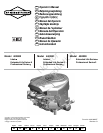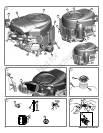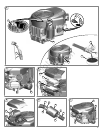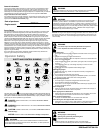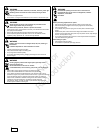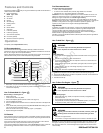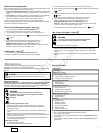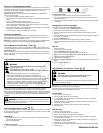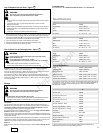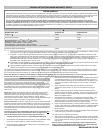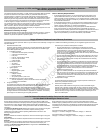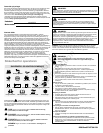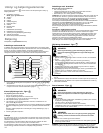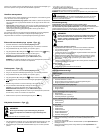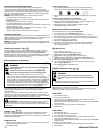
7
en
Determine The Starting System
Before startingthe engine, youmust determine thetype of starting systemthat is onyour
engine. Your engine will have one of the following types.
Electronic Fuel ManagementSystem: This features an Electronic Control Unit that
monitors engine and temperature conditions. It does not have a manual choke or a
primer.
Choke System: This features a choke to be used for starting in cooltemperatures.
Some models will have a separate choke control while others will have a
combination choke/throttle control. This type does not have a primer.
To start your engine, follow the instructions for your type of starting system.
Note: Some engines and equipment have remote controls. See the equipment manual
for location and operation of remote controls.
Electronic Fuel Management System - Figure
4
1. Check the oil level. See the How To Check/Add Oil section.
2. Make sure equipment drive controls, if equipped, are disengaged.
3. Turn the fuel shut-off valve (A), if equipped, to the on position (Figure 4).
4. Move the throttlecontrol (B)tothefast
position. Operate the enginein the fast
position.
5. Turn the electric start switch (D) to the on/start position (Figure 4).
NOTE: If the engine does not start after repeated attempts, go to
BRIGGSandSTRATTON.COM or call 1-800-233-3723 (in USA).
NOTICE: To extend the lifeof the starter, use short starting cycles (five seconds
maximum). Wait one minute between starting cycles.
Choke System - Figure
4
1. Check the oil level. See the How To Check/Add Oil section.
2. Make sure equipment drive controls, if equipped, are disengaged.
3. Turn the fuel shut-off valve (A), if equipped, to the on position (Figure 4).
4. Move the throttlecontrol (B)tothefast
position. Operate the enginein the fast
position.
5. Move the choke control (C), or the combination choke/throttle lever, to the choke
position.
Note: Choke is usually unnecessary when restarting a warm engine.
6. Turn the electric start switch (D) to the on/start position (Figure 4).
NOTE: If the engine does not start after repeated attempts, go to
BRIGGSandSTRATTON.COM or call 1-800-233-3723 (in USA).
NOTICE: To extend the lifeof the starter, use short starting cycles (five seconds
maximum). Wait one minute between starting cycles.
7. As the engine warms up, move the choke control (C)totherun
position.
How To Stop The Engine - Figure
4
WARNING
Fuel and its vapors are extremely flammable and explosive.
Fire or explosion can cause severe burns or death.
Do not choke the carburetor to stop engine.
1. Move the throttle control to the slow position. Turn the key switch (D) to the off
position (Figure 4). Remove the key and keep in asafe place out of the reachof
children.
2. After the engine stops, turn the fuel shut-off valve (A), if equipped, to the closed
position.
Maintenance
We recommend that you see any Briggs & Stratton Authorized Dealer for all
maintenance and service of the engine and engine parts.
NOTICE: All the components used to build this engine must remain in place for proper
operation.
WARNING: When performing maintenance that requires the unit to be
tipped, the fuel tank must be empty or fuel can leak out and result ina fire or
explosion.
Emissions Control
Maintenance, replacement, orrepair of theemissions control devices andsystems
may be performed by any non-road engine repair establishment or individual.
However, to obtain “no charge” emissions control service, the work must be performed
by a factory authorized dealer. See the Emissions Warranty.
Unintentional sparking can result in fire or electric shock.
Unintentional start-up can result in entanglement, traumatic
amputation, or laceration.
Fire hazard
WARNING
Before performing adjustments or repairs:
Disconnect the spark plug wire and keep it away from thespark plug.
Disconnect battery at negative terminal (only engines with electric start.)
Use only correct tools.
Do not tamper with governor spring, links or other parts to increaseengine
speed.
Replacement parts must be of the same design and installed in the same
position as the original parts. Other parts may notperform as well, may damage
the unit, and may result in injury.
Do not strike the flywheel with a hammer or hard object becauset he flywheel
may later shatter during operation.
When testing for spark:
Use approved spark plug tester.
Do not check for spark with spark plug removed.
Maintenance Chart
First 5 Hours
Change oil
3
Every8HoursorDaily
Check engine oil level
Clean area around muffler and controls
Clean finger guard/rotating screen
Every 25 Hours or Annually
Clean air filter
1
Clean pre-cleaner
1
Every 50 Hours or Annually
Change engine oil
4
Replace oil filter (if equipped)
4
Check muffler and spark arrester
Every 100 Hours or Annually
Change engine oil
5
Replace oil filter
5
Annually
Replace air filter
Replace pre-cleaner
Replace spark plugs
Clean air cooling system
1
Replace fuel filter
Check valve clearance
2
1
In dusty conditions or when airborne debris is present, clean more often.
2
Not required unless engine performance problems are noted.
3
Only engines without oil filter.
4
Engines without oil filter or with standard black oil filter (see Specifications pagefor
part number).
5
Engines with high-efficiency yellow or orange oil filter (see Specifications page for
part number).
Not for
Reproduction



